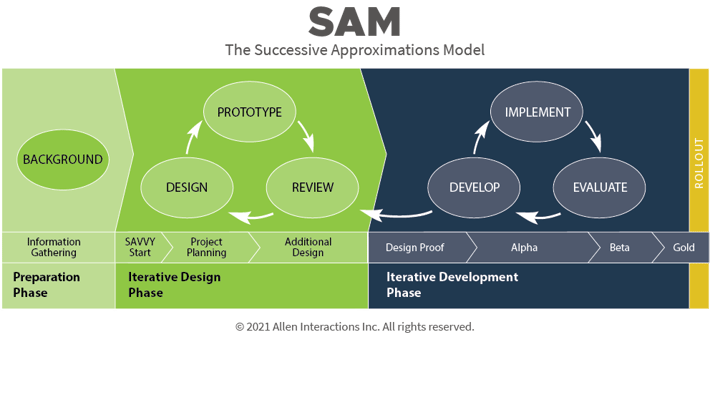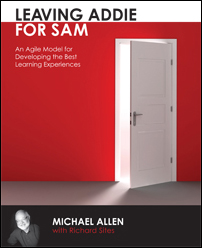Blog
Happy Anniversary to Leaving ADDIE for SAM!
It’s the end of January - which also means many New Year’s resolutions are also coming to an end. Of course, we can set goals and resolutions any ...

.png?width=1387&height=526&name=2024%20Blog%20Covers%20+%20Inline%20Graphics%20(6).png)
Stick to it! 5 ways to keep your learning resolutions with SAM
By Allen Interactions | January 08, 2015 | Custom Learning | 0 Comments
It’s the end of January - which also means many New Year’s resolutions are also coming to an end. Of course, we can set goals and resolutions any day, but it takes determination, a strategic approach, and repetition to succeed.
For many of us, we end up ditching our new year's resolutions. Why?
- We go big – making goals that are never attainable.
- We expect overnight results – setting timelines that are not realistic.
- We have too many resolutions – choosing everything we can think of to change.
- We don’t change our environment – the temptations that hinder our goals are still present.
In nearly every presentation or workshop we lead about SAM, we’re met with our peers recanting the challenges, limitations, and failures of trying to implement SAM. This is almost immediately followed with a question of “How can I make a Savvy Start happen?” or “Why didn’t this go any faster than our current process?” or “When should I present the Design Proof?” My responses are rarely about the process or components of SAM themselves, but rather about the same things which make our non-learning resolutions fail!
Any attempt to change a process that is currently in use in an organization takes more than just having a new process to start. It takes planning, setting expectations, focusing on small successes, and integrating into the organization.
We’re no strangers to having objectives and goals, so we’ve done the hard part and broken this resolution down to a simple list for you to get started with SAM. These resolutions can help you make this year and your instructional design projects a success. For best results, experiment with these tips one at a time, in any order. Don’t try to do them all at once!

Cut Back on Pre-Design Analysis
Find some way to start designing instruction before you worry too much about the content that is needed. Remember, identifying the problem is the first step in building realistic learning experiences.
Trying to get 5-6 people into an all-day workshop (or for two days) is a daunting task that rarely aligns with our schedules. Instead, schedule a four-hour brainstorming session with your key stakeholders, learning leaders, and recent learners to brainstorm and sketch out a couple of interactions. You can worry about the rest of the instruction later.
Create and Share an Expectations Document With Your TeamMake sure everyone is on the same page for your Mini Savvy. Write up a list of things everyone can expect to see at each stage of the SAM process and send it to all team members in advance. (If you’re not sure where to start, check out our SAM Starter Pack). You might already be doing something like this, so a simple tweak here or there to include prototypes or draft content may go a long way in shifting the expectations of the team.
Plan a Design ProofLet the team members know you will be putting together a rough version of the e-learning course for them to review before you move to development. Make sure they understand this is only a representation of the course and the “polished” version will be coming along later. This version is just to make sure that everything is on track.
Align Your Current Deliverables With SAMNow this is actually a big goal. While it may not take you long to link the Design Proof with some type of storyboard you may currently use, it will help you see where other quick successes can occur the next time you start a project. It will certainly go a long way in helping your team members understand how SAM addresses many (if not all) of your organization’s expectations for learning and development projects.
Let's Go!
You have a small set of realistic SAM goals for the year. You are going to start small. You do not expect overnight changes. You will limit your efforts to one or two key events. And because you realize that no process occurs in a vacuum, you’ll have a renewed appreciation for your organization’s current needs.
Best of luck making SAM a success in your organization! (If things don’t work out, we’re always here for advice and guidance. Check the Allen blog regularly for even more tips and tricks!)
.png?width=135&height=135&name=ai-symbol-green%20(3).png)
About the Author: Allen Interactions
Comments
Would you like to leave a comment?
Related Blog Posts

By: Allen Interactions | Sep, 2013
Category: Custom Learning, Strategic Consulting, Dr. Michael Allen
1.jpg?width=316&name=leavingaddieforsam(small)1.jpg)
Blog
Leaving ADDIE for SAM: eLearnChat Interview with Michael Allen
It’s the end of January - which also means many New Year’s resolutions are also coming to an end. Of course, we can set goals and resolutions any ...
By: Allen Interactions | Oct, 2012
Category: Custom Learning, Strategic Consulting

Blog
Upcoming Webinar: Meet SAM
It’s the end of January - which also means many New Year’s resolutions are also coming to an end. Of course, we can set goals and resolutions any ...
By: Allen Interactions | Nov, 2012
Category: Custom Learning, Strategic Consulting

